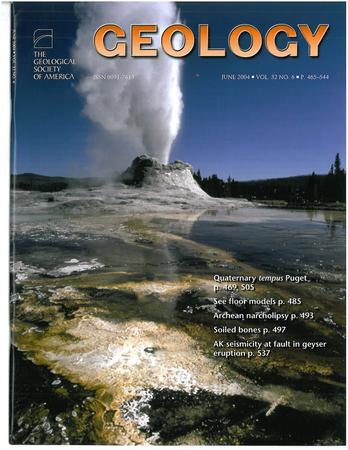中新世中干旱低纬度气候的有限变暖:块状同位素在sabkha环境中的应用
IF 4.6
1区 地球科学
Q1 GEOLOGY
引用次数: 0
摘要
由于缺乏档案和代理资料,重建炎热干旱地区过去的气候是具有挑战性的。sabkha方解石-文石矿物上的团块同位素(∆47)可能会缓解这种情况。我们将∆47技术应用于现代和中新世中期sabkha样品,得到的温度为25.2±2.8°C至32.1±3.0°C。结果表明,sabkha方解石文石矿物主要反映夏季半年温度,是降水最多的季节。重建的δ18Owater (SMOW - standard mean ocean water)值(3.2±1.0‰和5.2±1.2‰)与潮间带、潮上带和泻湖的蒸发强度呈正相关。尽管中新世中期大气CO2较高,但重建的sabkha温度与现代值相似,表明气候敏感性较低。因此,sabkha∆47对于低纬度大陆环境下的古温度重建是一个有价值的工具。本文章由计算机程序翻译,如有差异,请以英文原文为准。
Limited warming of middle Miocene arid low-latitude climates: Application of clumped isotopes in sabkha environments
Reconstructing past climates in hot, arid regions is challenging due to scarce archives and proxies. Clumped isotopes (∆47) on sabkha calcite-aragonite minerals might alleviate this situation. We apply the ∆47 technique to modern and middle Miocene sabkha samples yielding temperatures of 25.2 ± 2.8 °C to 32.1 ± 3.0 °C. Results show that sabkha calcite-aragonite minerals mainly reflect summer half-year temperatures, when most precipitation occurs. Reconstructed δ18Owater (SMOW) (SMOW—standard mean ocean water) values (3.2 ± 1.0‰ and 5.2 ± 1.2‰) scale with the intensity of evaporation in these intertidal, supratidal, and lagoonal settings. Despite higher middle Miocene atmospheric CO2, reconstructed sabkha temperatures are similar to modern values, suggesting a low climate sensitivity. Thus, sabkha ∆47 is a valuable tool for paleotemperature reconstructions in low-latitudes continental settings.
求助全文
通过发布文献求助,成功后即可免费获取论文全文。
去求助
来源期刊

Geology
地学-地质学
CiteScore
10.00
自引率
3.40%
发文量
228
审稿时长
6.2 months
期刊介绍:
Published since 1973, Geology features rapid publication of about 23 refereed short (four-page) papers each month. Articles cover all earth-science disciplines and include new investigations and provocative topics. Professional geologists and university-level students in the earth sciences use this widely read journal to keep up with scientific research trends. The online forum section facilitates author-reader dialog. Includes color and occasional large-format illustrations on oversized loose inserts.
 求助内容:
求助内容: 应助结果提醒方式:
应助结果提醒方式:


